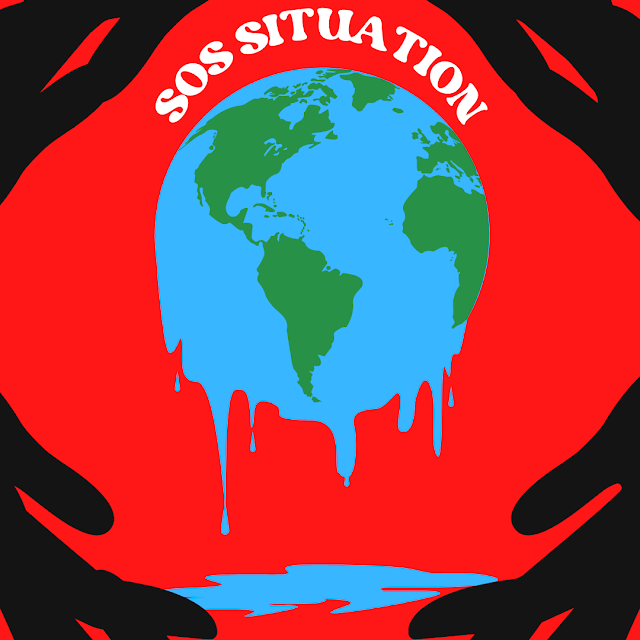SOS Situation
By Syed Ahmad Rufai

SOS Situation (Illustration/Syed Ahmad Rufai)
A silent nature’s environmental crisis i.e. climate change poses a
threat any bigger than a nuke attack. It overall impacts the glaciers, society,
rivers, forests, economy and ecosystem.
The CO2 levels are rising since 1950’s industrial revolution, and
the widely accepted reason behind it are human activities. The planet is
getting warmer rapidly due to consumption of fossil fuels and products obtained
from animals emitting methane.
The UN predicts earth getting warmer by 2% w.r.t pre-industrial stage
by the year 2100, but we are already at 1.5%. The factors add on to the crisis-
heat waves around the world and temperature hitting the highest mercury of all
times has taken lives of few until now. Europe being colder than the Artic…. sea
levels are rising due to warmer temperatures.
But, the repercussions are wider. Climate Change has had deleterious
impact on the cold valley cupped between mountains. The valley falls under the
Himadri ranges of Himalayan Mountains. Known for its harsh winter when snow
clad mountains and plains would enhance its beauty, it stands on the edge of
unpredictability. The snow received has declined over the past three decades
now.
For Kashmir, the temperatures are hitting high making summers hotter
and winters less coldly. Extensive snowfall yesteryear damaged apple orchards, while
as last year it snowed negligibly low signifying erratic weather pattern.
The Indian Meteorological Department presented data suggesting 9 to
12 degrees of temperature rise between February and April. The Kolhai glacier
also recorded a good amount of snowfall this year but melted fast due to
soaring heat.
The Brengi Nallah sinkhole, droughts and flood like situation occurring
simultaneously in June can lead to economical crisis too. Kashmir’s economy
mainly operates on agriculture and horticulture, which remained affected due to
irregular weather patterns. The paddy cultivation nearly halted due to drought
like situations and cultivators faced tribulations due to unfavorable weather
for growth of fruits and vegetables.
The production of rice, wheat, maize, pulses, oilseeds etc have
significantly decreased.
It is made sure that in every student in each standard is made aware
of this fact that “The earth’s average temperature is increasing due to global
warming, which in turn is increasing the greenhouse gas in atmosphere produced
by human activities such as deforestation, burning of fossil fuels, unplanned
industrialization etc”.
Anthropogenic activities are an adding factor leading to global
warming and in turn affecting climate resulting in warmer temperatures.
According to a 2019 data report, the UT has recorded a 1.2% Celsius rise in
temperature. For Kashmir the AQI (Air Quality Index) stands at 70
Another factor that adds to Kashmir’s warmer temperatures is the
emission of green house gases by western countries carried by air to this part
of the world. Soaring temperatures changes the precipitation pattern that leads
to decrease in snowfall.
According to a report, Kashmir has more than a million vehicles on
road, which was around 6 lakh in 2008.
The valley encompasses an area of 2,22,236 sq km, around 20230 sq km
comprises of forest cover. Due to illegal construction, wood smuggling, and unplanned
litter management at high ranges has degraded forests all together.
The global population is shooting up, tripling over the past 70
years, causing another reason for people to move more towards unplanned
urbanization.
The developmental activities in the name of industrialization and
urbanization lead to environmental degradation. One such activity came into
limelight when after the widening of the Jammu-Srinagar highway; it observed
frequent landslides for vehicular movement.
Some natural phenomenon like flash floods, cloud bursts, landslides and
many more are unprecedented but the increase in them can be a sign of climate
change.
The famous Dal Lake, is also being fed with lethal toxins dumped
into it by the hotels and restaurants along boulevard road. In an effort to
make it look cleaner, the water levels are raised from the Boulevard side of
Dal. But Dal’s interiors are all pungent and face the brunt of these unethical
activities.
But, the flag bearers of climate change anywhere in the world should
be made privy that a finite planet can’t see infinite growth, which will
eventually lead to destruction caused by nature.
USA, Russia, Turkey and other countries work more towards opening
coal plants. While as global modals can be implemented on small scales, one
being when world leaders signed Paris Agreement in 2016, to control carbon
emissions to maintain the planet heat of 2% by 2100.
Prevailing conditions can also lead to a famine, as it had occurred
twice in 1800’s, caused by heavy rainfall and snowfall at harvest time.
In May 2022, Lieutenant Governor, Manoj Sinha also acknowledged that
valley is facing worst of climate change. But, the budget for afforestation in
Kashmir is less than 2%.
Apart from government framing policies for the same, Individualism
is the key to resolve climate change issue. Starting renewable energy projects
can be another option to cope up with rising carbon emission leading to overall
climate change. Providing free public transport to encourage people not to use
private vehicles.
Is that the end then, yes, maybe? An Australian think tank warned
that climate change can bring end to civilization by 2050.


Comments
Post a Comment